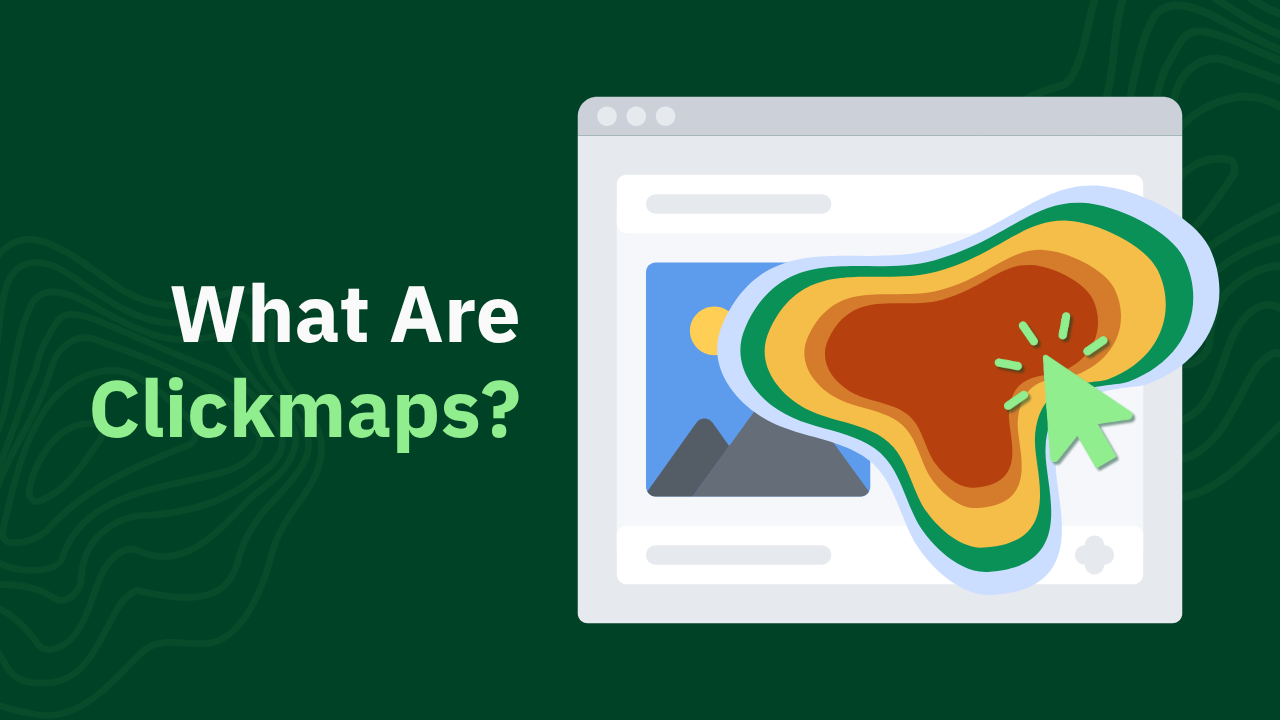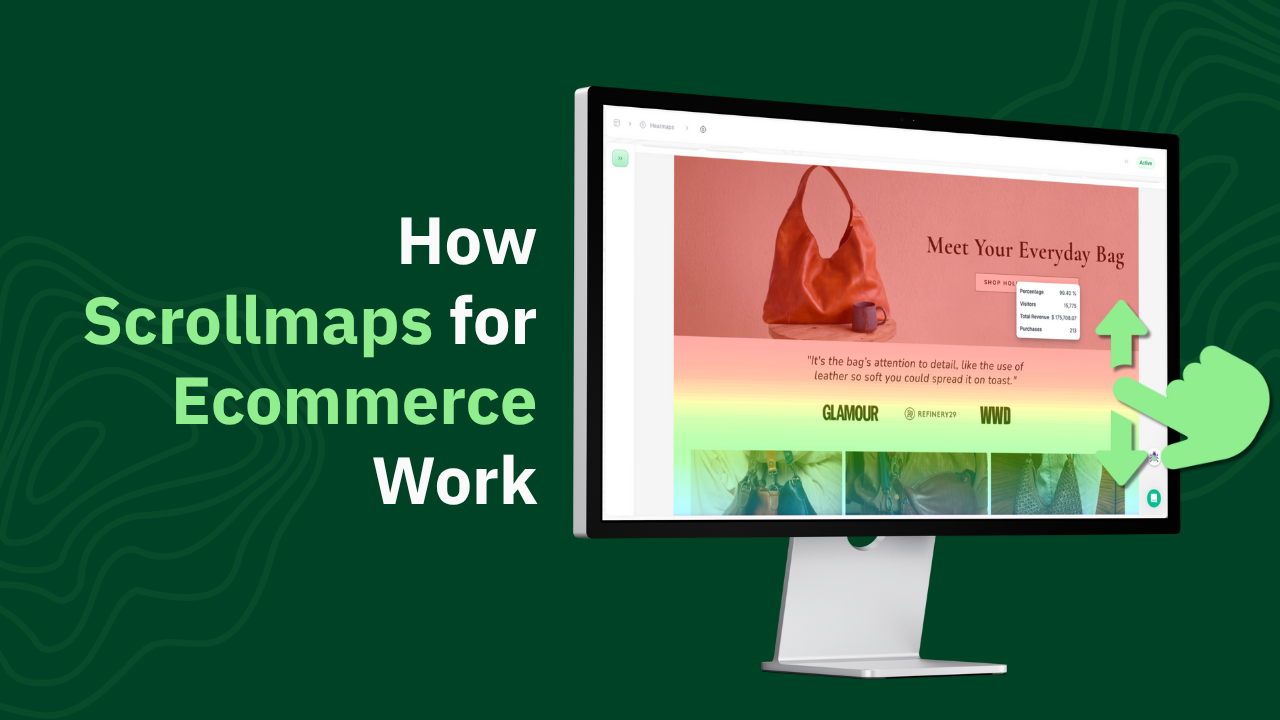What Are Clickmaps? Definition, Examples & 8 Best Tools for Ecommerce

Learn what clickmaps are, how they differ from heatmaps, and which clickmap tools work best for ecommerce stores. Compare 8 options with pricing and features for 2025.

Clickmaps are visual representations showing where visitors click on your website pages. Unlike traditional analytics that show click counts in tables, clickmaps overlay colored dots or heat gradients directly on your page layout, making it easy to see which elements get the most attention. For ecommerce stores, clickmaps reveal whether customers click product images, trust badges, or navigation elements before making purchases.
You know people are clicking around your store. Your analytics show total clicks and pageviews. But where exactly are they clicking? Which product image gets more attention? Does anyone click your size chart? Are mobile visitors tapping on non-clickable elements expecting something to happen?
Clickmaps answer those questions by showing you a visual overlay of every click on your pages. Red spots mean lots of clicks. Blue areas mean few clicks. You see your actual page layout with click data layered on top, so you can immediately identify what's working and what's being ignored.
If you're already familiar with heatmap tools and want to see platform comparisons, check out our guides on the best heatmap tools for ecommerce, Hotjar alternatives, and Shopify heatmap tools. Otherwise, let's break down what clickmaps actually do and which tools work best for online stores.
What Are Clickmaps? (Simple Definition)
A clickmap is a data visualization tool that shows where visitors click on your website. Think of it as taking a screenshot of your page and covering it with colored dots or heat gradients representing click activity. Each click creates a visual marker on the exact spot where it occurred.
Clickmaps typically use color coding:
- Red or dark colors indicate high click activity
- Yellow or orange show moderate clicking
- Blue or cool colors represent low click activity
- Sometimes individual dots show specific clicks
The visual format makes patterns obvious immediately. You don't need to analyze spreadsheets or click through reports. Just look at your page and see where the action happens.
How Clickmaps Work
Clickmap tools install tracking code on your website that records every click or tap. The code captures:
- X and Y coordinates of each click
- Which page element was clicked
- Timestamp of the interaction
- Device type (desktop, mobile, tablet)
- Sometimes user information like returning versus new visitor
This data gets sent to the clickmap platform, which processes it and generates the visual overlay. Most tools aggregate clicks over time to show patterns rather than individual clicks.
For mobile devices, clickmaps track tap locations instead of mouse clicks. Touch interactions work differently than mouse clicks, so good clickmap tools account for that difference in their visualizations.
Clickmaps vs Heatmaps: What's the Difference?
People often use these terms interchangeably, but they're technically different visualization types:
Clickmaps show only click and tap interactions. Every click creates a data point on the map. They answer: "Where do people click?"
Heatmaps can show multiple types of data including clicks, mouse movement, scroll depth, and hover behavior. They answer broader questions about engagement and attention.
Scrollmaps (a type of heatmap) show how far down the page people scroll. They use color gradients to indicate what percentage of visitors see different sections of your page.
Move maps track mouse movement patterns, showing where people move their cursor even if they don't click.
Most tools marketed as "heatmap tools" actually provide all these visualization types including clickmaps. When someone says they're using heatmaps, they usually mean they're tracking clicks, scrolls, and movement together.
For ecommerce stores, clickmaps are typically the most useful because you care about interactions with specific elements: product images, "Add to Cart" buttons, trust badges, size charts. Scroll data helps too, but clicks directly correlate with engagement.
What Clickmaps Tell You About Your Ecommerce Store
Clickmaps reveal specific behavior patterns that impact your sales:
Product Page Insights:
- Which product images get clicked most (main image versus thumbnails)
- Whether anyone clicks on zoom functionality
- If customers use product image galleries
- Which product details sections get attention (specifications, reviews, shipping info)
Navigation Patterns:
- How people use your menu structure
- Which collection categories get clicked
- If your search bar gets used
- Whether mobile hamburger menus work
Trust and Credibility:
- If anyone clicks your trust badges and security seals
- Whether customers read your return policy before buying
- If shipping information gets attention
- Whether your customer reviews get clicked
Cart and Checkout Issues:
- Where people click expecting something to happen but nothing does (rage clicks)
- Which elements cause confusion during checkout
- If mobile users struggle with button placement
- Whether discount code fields distract from checkout completion
Non-Clickable Element Problems:
- Images that aren't clickable but people try to click them
- Text that looks like a link but isn't
- Buttons that don't work properly
- Elements positioned where users expect interactive features
Real Clickmap Examples for Ecommerce
Example 1: Product Image Clicks
A clothing store's clickmap showed 800 clicks on product images daily, but the images weren't set to zoom. Customers expected to see fabric details and fit but clicked on static images. After making images zoomable, the store saw 12% fewer returns because customers could see products more clearly before purchasing.
Example 2: Size Chart Positioning
A footwear store's clickmap revealed 340 daily clicks on their size chart, but it was buried in a tab below product descriptions. Most clicks happened after customers already added items to their cart. Moving the size chart above the "Add to Cart" button reduced returns by 8%.
Example 3: Mobile Navigation Problems
A home goods store saw 600 daily clicks on their mobile logo, with customers expecting it to open navigation. The hamburger menu icon got only 200 clicks. The clickmap revealed the logo was more intuitive for mobile shoppers. They added navigation to the logo click and saw 15% more mobile product views.
Example 4: Trust Badge Placement
An electronics store placed trust badges at the bottom of product pages. Their clickmap showed only 40 clicks per day. After moving badges next to the "Add to Cart" button, clicks increased to 280 per day and conversion rate improved 6%.
The 8 Best Clickmap Tools for Ecommerce Stores
1. Heatmap: Best for Revenue Attribution
Best for: Stores wanting to connect clicks to actual revenue
Pricing: Starts at $117/month for stores with $0-$4.9M ARR
Key Features:
- Clickmaps with revenue attribution
- Shows dollar value per clicked element
- AI recommendations based on click data
- 2-minute installation
- Shopify, WooCommerce, BigCommerce integrations
Why It's Best: Heatmap goes beyond showing where people click by connecting each click to revenue data. Your clickmap shows that your product comparison feature generated $6,800 in sales while your hero image only drove $2,100 despite similar click volumes.
The platform tracks clicks through to purchase, so you can see which interactions lead to completed orders versus which just create engagement that goes nowhere. That changes how you prioritize optimization work.
Pros:
- Only clickmap tool showing revenue per click
- Built specifically for ecommerce
- Fast setup process
- Mobile click tracking included
Cons:
- Higher price than basic clickmap tools
- Less useful for very low traffic stores
- Requires ecommerce platform integration
Rating: 4.7/5
Free Trial: 14 days
2. Hotjar: Best Known General Tool
Best for: General websites and stores wanting clickmaps plus surveys
Pricing: Starts at $39/month
Key Features:
- Click, move, and scroll maps
- Session recordings
- On-site surveys
- Form analysis
- Funnel tracking
Why It's Popular: Hotjar is the most recognized name in clickmap and heatmap tools. It covers basics well without specialized features. If you're not sure what you need yet, Hotjar provides clickmaps, movement tracking, and scroll data in one package.
The survey tools let you ask visitors why they clicked certain elements or what confused them, combining behavioral data from clickmaps with qualitative feedback.
Pros:
- Most established brand
- Large user community
- Includes surveys and feedback
- Good documentation
Cons:
- No revenue tracking
- Generic tool not built for ecommerce
- Mobile tracking accuracy issues reported
- Key features locked in higher tiers
Rating: 4.3/5
Free Trial: Yes, limited features
3. Microsoft Clarity: Best Free Clickmap Tool
Best for: Budget-conscious stores testing clickmaps
Pricing: Free forever
Key Features:
- Unlimited clickmaps
- Rage click detection
- Dead click identification
- Session recordings
- Fast, clean interface
Why It Works: Microsoft Clarity provides clickmap functionality for free with no limits on traffic or sessions. The rage click detection automatically identifies spots where visitors repeatedly click things that don't work, common on ecommerce sites.
Dead click detection finds elements people try to click but aren't actually clickable. Useful for catching images or text that customers expect to interact with.
Pros:
- Completely free
- No session limits
- Rage and dead click detection
- Clean visualization
Cons:
- No revenue tracking
- Basic reporting
- No ecommerce-specific features
- Manual installation
Rating: 4.5/5
Free Trial: Not applicable (permanently free)
4. Crazy Egg: Best for Click Testing
Best for: Stores testing different page layouts
Pricing: Starts at $29/month
Key Features:
- Clickmaps and scrollmaps
- Built-in A/B testing
- Session recordings
- Snapshots for tracking changes
- Confetti view for segmented clicks
Why Consider It: Crazy Egg's confetti view shows individual clicks as colored dots, letting you segment click data by traffic source, device type, or visitor type. You can see that mobile clicks cluster differently than desktop clicks on the same page.
The A/B testing integration means you can test layout changes and immediately see how click patterns change between variations.
Pros:
- A/B testing included
- Confetti view for segmentation
- Snapshot comparisons
- Lower price point
Cons:
- No revenue tracking
- Older interface
- Limited recordings on base plan
- No ecommerce features
Rating: 4.4/5
Free Trial: 30 days
5. Mouseflow: Best for Click Analysis
Best for: Stores needing detailed click filtering
Pricing: Starts at $39/month
Key Features:
- Clickmaps with advanced filtering
- Friction scoring for problem clicks
- Form analytics
- Funnel analysis
- Geographic click data
Why It Helps: Mouseflow's friction scoring automatically identifies problematic click patterns. Areas with high rage clicks (repeated clicking) or dead clicks (clicking non-interactive elements) get flagged automatically.
The form analytics track clicks on each form field during checkout, showing you which fields cause people to pause or abandon.
Pros:
- Advanced click filtering
- Friction scoring automation
- Field-level click tracking
- Geographic data
Cons:
- No revenue attribution
- Session limits on lower tiers
- Interface looks dated
- Basic ecommerce features
Rating: 4.6/5
Free Trial: 14 days
6. Lucky Orange: Best Budget Clickmap Tool
Best for: Small stores needing clickmaps and chat
Pricing: Starts at $10/month
Key Features:
- Real-time clickmaps
- Live chat integration
- Dynamic heatmaps
- Session recordings
- Form analytics
Why Stores Use It: Lucky Orange costs $10/month and includes live chat with clickmaps. If you're a small store, you get both tools for less than most standalone clickmap platforms charge.
The real-time clickmap feature shows current visitor clicks as they happen, useful for watching how people interact with new page layouts immediately after launch.
Pros:
- Very affordable
- Live chat included
- Real-time click viewing
- Good for small stores
Cons:
- Session limits fill quickly
- No revenue tracking
- Basic clickmap features
- Limited filtering
Rating: 4.3/5
Free Trial: 7 days
7. Smartlook: Best for Mobile Click Tracking
Best for: Stores with mobile apps and websites
Pricing: Starts at $55/month
Key Features:
- Cross-platform clickmaps (web and mobile)
- Automatic event tracking
- Session recordings
- Mobile app click tracking
- Crash reports
Why Consider It: Smartlook tracks clicks across both your website and mobile shopping app. Most clickmap tools only work for websites. If you need to understand mobile app click behavior, Smartlook handles it.
The automatic event tracking captures clicks without manual setup, recording every tap and interaction automatically.
Pros:
- True mobile app support
- Automatic click tracking
- Cross-platform data
- 30-day trial
Cons:
- More expensive
- Recording bugs reported
- No revenue tracking
- Price increases with traffic
Rating: 4.6/5
Free Trial: 30 days
8. Fullstory: Best Enterprise Clickmap Platform
Best for: Large stores with optimization teams
Pricing: Custom pricing (typically $500+/month)
Key Features:
- Advanced click segmentation
- Error tracking for broken clicks
- Retroactive click analysis
- Custom dashboards
- Omnichannel tracking
Why Enterprise Stores Choose It: Fullstory provides enterprise clickmap features including retroactive analysis. You can filter clickmaps by customer segment, cart value, or specific user groups after data collection.
The error tracking identifies technical issues that break click functionality, alerting you immediately when buttons stop working.
Pros:
- Enterprise segmentation
- Retroactive filtering
- Technical error tracking
- Advanced analysis
Cons:
- Very expensive
- Complex setup
- Overkill for small stores
- No transparent pricing
Rating: 4.5/5
Free Trial: 14 days
Quick Comparison Table
How to Use Clickmaps to Improve Your Store
Step 1: Install a clickmap tool and collect at least two weeks of data. You need enough clicks to identify patterns, not outliers. Weekend traffic often clicks differently than weekday traffic.
Step 2: Start with your highest-traffic pages. Product pages, collection pages, and homepage. These generate the most data and have the biggest impact on conversions.
Step 3: Look for obvious problems first. Rage clicks (repeated clicking in frustration), dead clicks (clicking non-interactive elements), or completely ignored elements that should be getting attention.
Step 4: Check mobile clickmaps separately from desktop. Mobile visitors tap differently than desktop users click. Your navigation that works great on desktop might be invisible on mobile.
Step 5: Compare click patterns to your conversion rate. Pages with lots of clicks but low conversion might have engagement without clear paths to purchase. Pages with few clicks might be confusing or broken.
Step 6: Test one change at a time. Fix the biggest problem, wait two weeks, check if click patterns improved. Don't change ten things at once or you won't know what worked.
Step 7: Focus on clicks that lead to revenue. If your clickmap tool tracks revenue (like Heatmap does), prioritize optimizing high-revenue click areas over high-engagement areas that don't drive sales.
Common Questions About Clickmaps
What's the difference between clickmaps and heatmaps?
Clickmaps specifically show click and tap data. Heatmaps can show multiple data types including clicks, mouse movement, and scroll depth. Most tools provide both, so when people say "heatmaps" they usually mean clickmaps, scrollmaps, and movement maps together.
Do clickmaps work on mobile devices?
Yes. Good clickmap tools track tap interactions on mobile devices. Touch interactions work differently than mouse clicks (you can tap but not hover), so mobile clickmaps show only tap locations, not movement data.
How many clicks do I need before clickmap data is useful?
At least 100-200 clicks per page element for meaningful patterns. Below that, individual visitor quirks skew the data. For low-traffic stores, collect data for at least a month before making decisions based on clickmaps.
Can clickmaps show who clicked specific elements?
Most tools aggregate clicks to show patterns, not individual users. Privacy regulations also limit tracking specific users. Clickmaps show overall behavior, not personal identities.
Do clickmap tools slow down my website?
Quality tools add minimal load time, typically under 100ms. We tested Heatmap and saw less than 50ms added. Poor clickmap tools can add several seconds of delay, hurting your conversion rate.
What's a rage click and why does it matter?
A rage click occurs when someone repeatedly clicks the same element in frustration, usually because it's not working or not responding fast enough. Indicates broken functionality or confusing UX that's costing you sales.
Can I track clicks on specific user segments?
Advanced tools like Fullstory and Heatmap allow segmentation by visitor type, traffic source, or cart value. Basic tools show aggregate click data for all visitors combined.
How long should I collect clickmap data before making changes?
At least two weeks covering different days and times. Weekend clicks differ from weekday clicks. Seasonal stores need a full cycle before making major changes.
Do clickmaps work with dynamic content?
Depends on the tool. Static pages work everywhere. Dynamic content that changes based on user behavior can confuse simpler clickmap tools. Heatmap and Fullstory handle dynamic content better.
Should I track clicks on every page or just important pages?
Focus on high-impact pages: product pages, collection pages, homepage, checkout. Tracking every page creates overwhelming data. Start with pages that directly affect revenue.
Ready to See Clickmaps in Action?
Clickmaps show you where visitors click. Revenue-tracking clickmaps show you which clicks actually generate sales. For ecommerce stores tired of optimizing based on engagement that doesn't convert, connecting click data to revenue changes everything.
Ready to see which clicks drive revenue? Use Heatmap and connect your click data to your bottom line..
How You Can Do It:
1: Download heatmap
2: Wait for 5k sessions
3: Reorganize products based on the highest revenue per session from top left to bottom right.

Founder of heatmap, SplitTesting.com, and multiple ecommerce brands. Lifelong optimizer, CRO-lover, and data nerd.
You made it all the way down here?
Might as well give us a shot, right? It'll change the way you approach CRO. We promise. In fact, our friend Nate over at Original Grain used element-level revenue data from heatmap to identify high-impact areas of his website to test, resulting in a 17% lift in Revenue per Session while scaling site traffic by 43%. Be like Nate. Try heatmap today.




